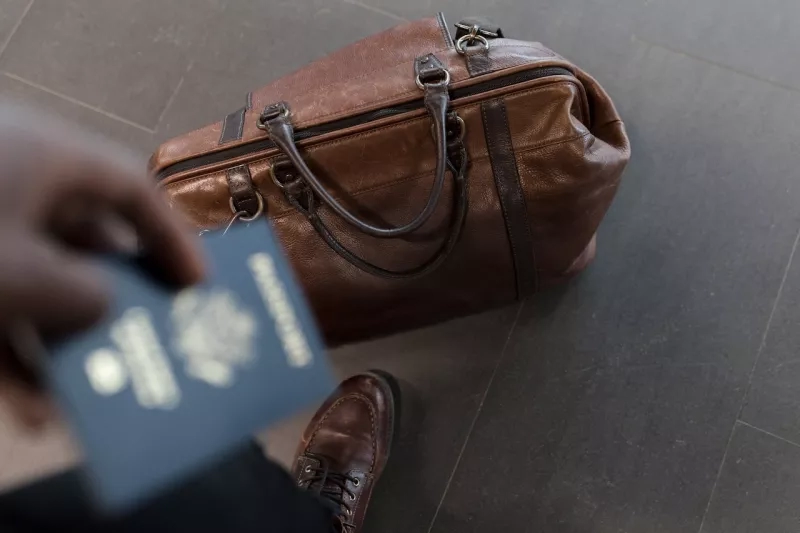Business travel includes any travel for work-related purposes. Popular types of business travel include meetings, conferences, sales kickoffs, trade shows, leadership retreats, and more.
Business travel has always been an integral part of the corporate world. It provides opportunities to meet clients face-to-face, attend conferences and networking events, and explore new markets.
However, as much as business travel can be exciting, it also comes with its fair share of challenges. From flight delays and cancellations to tracking approvals and keeping spending in check, numerous obstacles can make business travel stressful and overwhelming.
In this blog, we will explore the challenges and solutions of business travel and provide insights on how businesses can optimize their policies and practices to make them more efficient, cost-effective, and enjoyable for everyone involved.
What is Business Travel?
Millions of professionals worldwide engage in business travel each year. Business travel is when you hit the road or take to the skies for work-related purposes. So, if you've ever traveled across state lines for a meeting or hopped on a plane for a conference, you've been on a business trip.
According to the Bureau of Transportation Statistics, Americans take over 400 million long-distance business trips yearly, accounting for roughly 16% of all long-distance travel.
What is the Importance of Business Travel?
It's clear that business travel is a significant part of many companies' operations, but what motivates them to send their employees on these journeys? There are several reasons why companies invest in business travel. Here are some of them:
1. Closing Deals
Business deals often involve significant negotiation, and in-person meetings can be critical to reaching an agreement. When people meet in person, they can build trust and establish personal connections that are difficult to achieve through virtual communication. As such, closing deals in person is a common reason for business travel.
2. Exploring New Markets
Companies looking to expand into new markets often send representatives to explore the conditions on the ground and conduct research. Visiting a new market can provide valuable insights into consumer behavior, local regulations, and cultural norms that can help companies tailor their products and services to a new audience.
3. Building Relationships
One of the primary advantages of business travel is its opportunity to build stronger relationships with clients, partners, and colleagues. While email, phone, and video conferencing are convenient, nothing beats face-to-face interactions regarding establishing trust and rapport.
You can pick up on nonverbal cues during in-person meetings and establish a more personal connection. It can lead to a deeper understanding of the other person's needs and goals, which can ultimately help you provide better service or products. Additionally, in-person meetings can help address any concerns or issues more quickly and efficiently, preventing them from becoming more significant problems down the line.
4. Networking
Attending industry events, trade shows, and conferences can provide networking opportunities, learning about new trends, and meeting potential clients and partners.
Networking can be invaluable for building relationships, finding new clients or partners, and staying up-to-date with industry best practices. For example, attending a trade show can provide opportunities to showcase your products or services, meet potential clients, and learn about the latest market trends.
5. Competitive Advantage
Companies prioritizing business travel and investing in face-to-face meetings with clients and partners can gain a competitive advantage over those relying solely on digital communication. By meeting with clients and partners in person, companies can establish more personal connections and build trust, leading to more business opportunities and revenue.
Here's a business travel checklist to make business travel for your employees less stressful.
Different Types of Business Travel
Business travel can take many forms, depending on the purpose of the trip and the activities involved. Here are some of the most common types of business travel:
- Event and Conference Travel: Companies often send employees to corporate events and conferences where attendees can learn and network with peers, potential clients, and service providers.
- Training and Education: Companies may send employees to conferences and workshops to learn about trends and best practices in their functional areas. These events can provide valuable opportunities for professional development and networking, helping employees stay up-to-date on the latest industry developments and build relationships with others in their field.
- Internal Meetings and Visiting Offices: National and multinational companies may need to send employees and leadership to other offices to discuss specific projects and business strategies or to build a more integrated organizational culture.
- Company Retreats: Some companies hold retreats annually or multiple times yearly to help teams grow stronger and build company culture through shared activities.
- Client Meetings: Maintaining solid relationships with existing clients is crucial for many businesses. Account managers and others may regularly visit their most prominent clients to check in on them, take them out for a meal or drink, and generally show gratitude for their business. These visits can strengthen relationships and potentially lead to additional business.
- Trade Fairs: Many organizations attend trade shows and expos to display their products and services and connect with potential clients. Attending these events can effectively generate leads and build relationships with potential customers, especially in industries where face-to-face interactions are critical.
- Transfers and Offshore Work: Long-term transfers involve relocating employees to a different city or country for a certain period, usually to work on a specific project or set up a new function or business process.
- Transient Travel:Business transient travelers typically refer to individuals who frequently travel for short periods, often for a business meeting or work-related. These travelers usually stay in hotels or temporary accommodations and frequently move between locations for work or other activities.
- Bleisure Travel: This hybrid travel style combines business and leisure travel, allowing employees to extend their business trips to leave time for sightseeing and relaxation. Bleisure travel can benefit employers and employees, encouraging employees to volunteer for business trips more often and providing a relaxing break.
Top Challenges To Manage Business Travel
As many businesses need help managing company travel, several issues affect day-to-day operations. These include:
1. Managing Large Numbers of Requests
When managing large numbers of travel requests, keeping track of all the information and ensuring that requests are processed efficiently can be challenging. It can result in delays and frustration for employees waiting for travel approvals or information.
For example, imagine a small company with just one finance person responsible for managing all travel requests. They receive requests from various team members in different formats—email, Slack messages, and in-person visits. It can lead to confusion and delays in processing the requests and distract the finance person from other essential tasks.
2. Tracking Approvals
It's a massive headache if your company's travel approvals are manually emailed. Tracking travel approvals can be time-consuming and prone to errors. It can result in missed approvals, delayed travel, and frustration for employees waiting for approval.
Imagine a team member submits a travel request, and the finance person then sends an email to the manager for approval. If the manager is busy or forgets to respond, the request may be delayed or even missed altogether, causing frustration for the employee who is scheduled to travel.
3. Keeping Spending in Check
Managing travel costs can be difficult, especially when employees book trips independently or through different channels. It can result in overspending and frustration for finance teams who aim to keep costs under control.
For example, imagine a company where employees book travel through different channels. Some employees book expensive hotels and flights, while others find cheaper options on discount travel websites. It can lead to inconsistency in travel costs and make it difficult for the finance team to manage and budget travel expenses.
4. Being Flexible
Flexible travel policies can result in consistency, especially when balancing cost control with employee satisfaction. It can result in frustration for both employees and finance teams.
For example, a business with restrictive travel policies can limit employees to specific airlines, hotels, and routes. It may help control costs, restrict employee options, and make travel less enjoyable. On the other hand, if policies are flexible, employees may book expensive options outside the budget.
5. Reducing Errors
Reducing errors in travel management can be challenging, but it is essential to ensure accurate tracking of expenses and approvals. This can help prevent delays and frustration for employees and finance teams.
How Companies Can Manage Business Travel
Companies must make the process straightforward to ensure that team members comply with travel policies. If the process is simple, team members will find ways to circumvent the rules, and compliance will improve. The following are some common pitfalls to avoid:
- Too many rules: Too many, incredibly confusing or contradictory, can be overwhelming and frustrating for team members. It can lead to non-compliance or errors.
- A high number of touches: Too many touchpoints, like requiring additional emails to managers for approval, can slow down the process and make it difficult.
- Lots of manual steps: Requiring team members to file printed documents and receipts can be time-consuming and create opportunities for errors.
- Unclear processes: If team members are unsure of the steps or rules they must follow, they may become frustrated and disengage from the process.
To ensure compliance and simplify the process, use a corporate travel management system that walks employees through each step. By automating the process and making it easy and intuitive, team members are more likely to follow the rules and comply with company policies.
What is a Business Travel Solution?
A travel management system is a software platform that helps companies manage their employees' travel-related activities and expenses. These systems can be purpose-built tools from third parties or developed in-house by large companies. However, building a travel management system from scratch doesn't make sense with the availability of corporate travel management tools out of the box for a relatively low cost.
These systems aim to oversee, regulate, and coordinate a company's employees' travel activities and expenses. Previously, a company's office administrators or a dedicated travel manager would handle these tasks. However, with a travel management system, these manual tasks can be streamlined or automated, freeing up staff for more valuable work than monitoring others' travel plans.
A business travel solution typically offers features such as online booking, expense tracking, policy compliance, travel budgeting, and reporting. They make booking, managing, and tracking business travel much simpler and more efficient for companies and their employees.
Conclusion
As a business, it's essential to recognize the value of investing in business travel. There are numerous reasons why companies send their employees on these trips, including closing deals, exploring new markets, holding internal meetings, prospecting, educating, and visiting existing clients. These opportunities provide valuable experiences and insights to enhance your company's operations and bottom line.
However, managing business travel can present challenges, such as managing large requests, tracking approvals, and dealing with changes in travel plans. To address these challenges, it's crucial to have a straightforward and streamlined travel policy outlining the process for requesting, approving, and booking travel and any expense and reimbursement policies.
Another essential aspect of managing business travel is providing support and resources to employees while on the road. It includes ensuring they have the necessary technology and tools to stay connected and productive, providing guidance on safety and security, and offering access to travel support services in emergencies.
By recognizing the importance of business travel and implementing strategies to manage it effectively, your company can reap the benefits of enhanced collaboration, improved relationships with clients and partners, and increased opportunities for growth and success.
So let your employees stay connected, build relationships and enjoy their next business trip!








